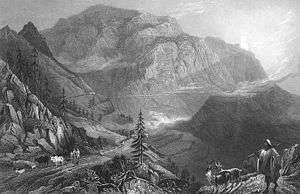Tons River
The Tons (टौंस नदी) is the largest tributary of the Yamuna and flows through Garhwal region in Uttarakhand, touching Himachal Pradesh. The Tons thrust is named after this river.
| Tons River | |
|---|---|
 Mohuna village, Deobun, Northwest of Landour - 1850s | |
| Native name | टौंस नदी (Hindi) |
| Location | |
| Country | India |
| Physical characteristics | |
| Source | |
| • location | Bandarpunch, Uttarakhand |
| Mouth | |
• location | Dehradun, Uttarakhand |
| Discharge | |
| • location | Yamuna |
the main source is Ruinsara snout , located below Dhum Dhar kandi ridge which leads to Kalanag and Banderpoonch and is one of the most major perennial Indian Himalayan rivers. In fact, it carries more water than the Yamuna itself, which it meets below Kalsi near Dehradun, Uttarakhand.[1][2]
Tons Valley
Tons Valley lies in Jaunsar Bawar region, as it emerges from the Himalayas has haridwar on its eastern bank. The cantonment town of Chakrata is situated between, the Tons and Yamuna rivers.
Tributaries
The Pabbar River is a tributary of the Tons River connecting to it from the west. The Pabbar River is the westernmost river that drains east to the Ganges. The Sutlej River is the next watershed over and is the easternmost river that drains west into the Indus. River is having siltation problem.
The Asan River is a tributary of the Tons that is often named (incorrectly) after this great river as the Tons. The Asan river is a confluence of two small river systems; one comprising streams flowing south from the Himalayan range running from Vikas Nagar towards Tehri (with Mussorie in the centre), and the other comprising streams flowing north-west from the lower Shiwalik hills (that separate Dehradun and Saharanpur districts). The misnomer Tons stands for the river originating from the Mussorie hills, flowing down through Robber's cave, Bijapur canal and Tapkeshwar Mahadev, before emerging into a broad valley behind IMA. This river receives substantial waters from several streams flowing south from the Himalayan slopes. It goes on west beyond the locality of Premnagar to finally join the streams from the lower Shiwaliks and flow toward the Yamuna, which it joins near Poanta Sahib. Asan barrage is constructed just before this confluence.
Identification with ancient Saraswati river
Research [3] points to the possibility of the ancient Saraswati river having had a source in the glacial waters of the Himalayas. The theory [4] states that the Tons river became a tributary of the Yamuna a few thousand years ago following a tectonic event in the Shiwalik range near Sirmaur district of Himachal Pradesh. If this is true, the Tons once ran an independent course somewhat parallel to the Yamuna, running south-west into Haryana where the Yamuna merged into it, and lower down the course into Punjab, where the Sutlej merged into it. This river was then the Saraswati mentioned in the Vedic texts as the greatest of all Indian rivers. However, this is just a theory and is yet to be universally accepted.
Geology
The top of the Tons river is in the Himalayan Crystalline complex. It then flows through Tethan Himalaya rocks before connecting to the Pabbar River in the Lesser Himalayan Sequence. The Tons flows into the Yamuna River after crossing into the Sub-Himalaya Sequence.
In Literature
An engraved plate of a rope bridge crossing in Fisher's Drawing Room Scrap Book, 1839, inspired the poem Crossing the River Tonse by a Jhoola by Letitia Elizabeth Landon in which the three strands of the rope are echoed by the three-lined verses.
| Wikisource has original text related to this article: |
Adventure sports
Along with Ganges, it has now become a major destination for water-based adventure sports like white-water rafting in Uttarakhand.[5] You can stay at Jaunsar Bawar region on the banks of the Tons river and enjoy the grade 4 rafting. Typical season for rafting in Tons is till July.
See also
- Ghaggar-Hakra River
- Markanda river, Haryana
- Sarsuti
- Tangri river
- Chautang
References
- Tons Archived 13 May 2008 at the Wayback Machine
- Jain, Sharad K.; Pushpendra K. Agarwal; Vijay P. Singh (2007). Hydrology and water resources of India- Volume 57 of Water science and technology library - Yamuna River. Springer. pp. 344–354. ISBN 1-4020-5179-4.
- K. S. Valdiya, The River Saraswati was a Himalayan-born river K. S. Valdiya Current Science, Vol. 104, No. 1, 10 January 2013, http://www.currentscience.ac.in/Volumes/104/01/0042.pdf
- https://www.scribd.com/document/380650060/Tracing-the-Origin-of-Saraswati-River-to-Tons-and-Baspa-Rivers
- "11 Top Destinations for River Rafting in India - Travel News India". travelnewsindia.com. 1 February 2017.